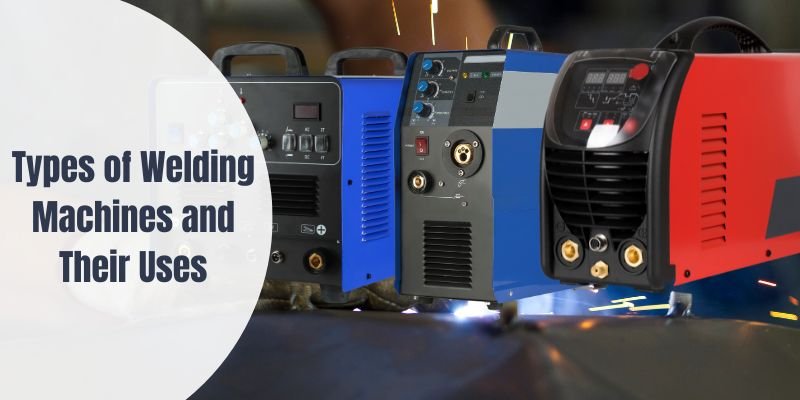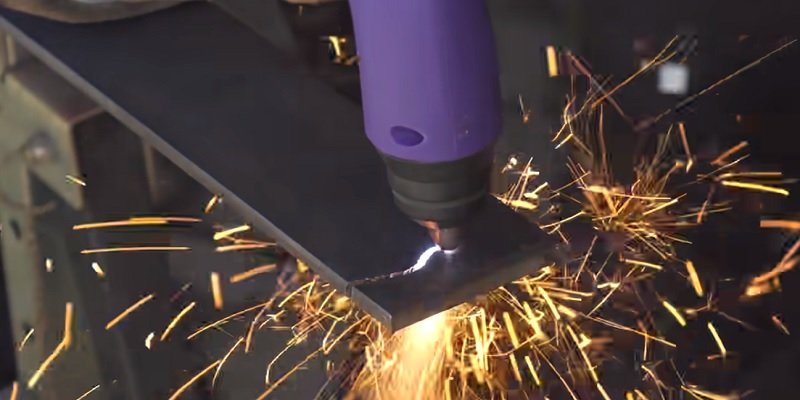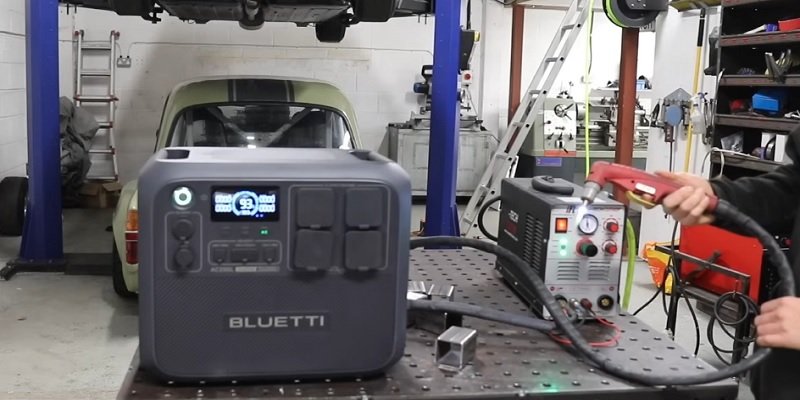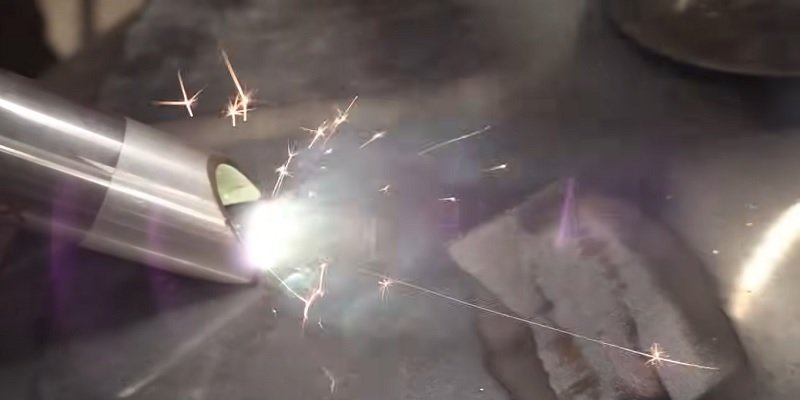Disclosure: This post contains affiliate links and I will be compensated if you make a purchase after clicking through my links. Learn More
Welding is a fundamental process in metal fabrication, construction, and manufacturing industries. Different welding machines cater to various applications, ensuring precision, strength, and durability in welds. In this article, we delve into the diverse landscape of welding machines, exploring their types and specific use cases.

Fundamentals of Welding Machines
When it comes to welding, a welding machine is essential. Welding machines are used to join metals by heating them to their melting point and adding a filler material to fuse them together. The welding process requires a lot of heat, and the welding machine is responsible for providing that heat.
Welding machines work by using an electrode to create an electric arc between the electrode and the metal being welded. The heat generated by the arc melts the metal, creating a weld pool. The weld pool then solidifies, forming a strong bond between the two pieces of metal.
The most common types of welding machines are MIG, TIG, and Stick. Each type of welding machine has its own unique advantages and uses. MIG welding machines are great for welding thicker metals, while TIG welding machines are ideal for welding thinner metals. Stick welding machines are versatile and can be used on a variety of metals.
Welding machines can be powered by different sources, including electricity, gas, or batteries. The power source used by the welding machine will affect its duty cycle, or the amount of time the machine can operate before needing to cool down.
In addition to the power source, welding machines also require shielding to protect the weld pool from contamination. This is typically done using a flux or gas. The shielding also helps to prevent oxidation, which can weaken the weld.
Overall, welding machines are essential tools for anyone working with metal. They provide the necessary heat to melt and fuse metals together, creating strong and durable bonds. Whether you’re a professional welder or a DIY enthusiast, a welding machine is a must-have tool in your arsenal.
Types of Welding Machines
There are various types of welding machines available in the market, each designed for specific welding tasks. In this section, we will discuss the most common types of welding machines and their uses.
Stick Welding Machines: Reliable and Portable
Stick welding machines, also known as Shielded Metal Arc Welding (SMAW) machines, are the most basic type of welding machine. They are affordable, portable, and easy to use. Stick welding machines are commonly used for welding steel, iron, and other metals in construction, fabrication, and repair work.
MIG Welding Machines: Versatile and Efficient
MIG welding machines, also known as Gas Metal Arc Welding (GMAW) machines, are versatile welding machines that can be used for a wide range of welding tasks. They use a wire electrode that is fed through a spool and a gun to create an arc that melts and fuses metals together. MIG welding machines are commonly used for welding thin metals, such as aluminum and stainless steel.
TIG Welding Machines: Precision and Cleanliness
TIG welding machines, also known as Gas Tungsten Arc Welding (GTAW) machines, are high-quality welding machines that produce precise and clean welds. They use a tungsten electrode that creates an arc that melts and fuses metals together. TIG welding machines are commonly used for welding aluminum, stainless steel, and other metals that require a high-quality finish.
Flux-Cored Arc Welding (FCAW)
Flux-Cored Arc Welding, or FCAW, takes the principles of GMAW and adds a twist. Instead of a solid wire, a tubular electrode filled with flux is used. As the electrode melts, the flux creates a protective gas, shielding the weld from atmospheric contaminants. This process shines when working outdoors or on materials with rust or other impurities. FCAW is a powerful tool in heavy equipment manufacturing and construction, where robust welds are essential for structural integrity.
Energy Beam Welding Machines
Energy beam welding machines use a high-energy beam, such as a laser or electron beam, to melt and fuse metals together. They are commonly used for welding metals that are difficult to weld with traditional welding machines, such as titanium and other exotic metals.
Submerged Arc Welding Machines: Heavy-Duty Welding
Submerged arc welding machines use a wire electrode and a granular flux that is fed through a nozzle to create a molten pool that fuses metals together. They are commonly used for welding thick metals, such as steel plates and pipes.
Plastic Welding Machines
Plastic welding machines use heat and pressure to melt and fuse plastic materials together. They are commonly used for welding plastic pipes, tanks, and other plastic products.
Gas Welders: Traditional and Versatile
Gas welding machines use a flame fueled by a mixture of oxygen and acetylene to melt metals and create welds. Although less common today, they remain relevant for artistic welding, plumbing, and repairing pipelines.
Ultrasonic Welders: Joining Thermoplastics
Ultrasonic welding utilizes high-frequency vibrations to create heat that melts and joins thermoplastic materials. This technique is prevalent in the automotive, electronics, and packaging industries, ensuring fast and clean welds.
Laser Welding Machines
Laser welding machines use the intense energy of a focused laser beam to create welds. The laser’s precision and minimal heat-affected zone make it an excellent choice for applications where preserving the material’s integrity is crucial, such as delicate medical devices and microelectronics.
Roll Welders: Seamless Rolling Joins
Roll welding involves feeding two metal parts between rotating rollers, generating heat and pressure that fuses the materials together. This method is employed in manufacturing pipes, tubes, and cylindrical components.
Induction Welders: Rapid Heating
Induction welding machines use electromagnetic induction to heat metals and create welds without direct contact. This method is popular in tube and pipe manufacturing, as well as in joining dissimilar metals.
Friction Welding Machines
Friction welding is a fusion process that harnesses the heat generated by rubbing two workpieces together at high speeds. Once the materials are sufficiently heated, pressure is applied to create a strong, reliable bond. This technique is utilized in industries that require rapid, high-quality welding, such as automotive and aerospace manufacturing.
Orbital Welding Machines
Orbital welding machines perform a beautiful dance around the workpiece. The welding torch rotates around a stationary workpiece, creating precise, repeatable welds. This method is ideal for applications that require consistent, high-quality welds in tubing and piping systems.
Resistance Spot Welders: Efficient Joining
Resistance spot welding machines join metals by applying pressure and passing an electric current through the materials. Widely used in the automotive industry, these welders ensure efficient and uniform joins, making them crucial for assembling vehicle bodies and components.
In summary, choosing the right type of welding machine depends on the specific welding task you need to perform. Each type of welding machine has its own advantages and disadvantages, so it’s important to choose the right one for your needs.
Welding Techniques and Their Uses

Stick Welding
Stick welding, also known as Shielded Metal Arc Welding (SMAW), is a welding technique that uses a stick electrode to create an arc between the electrode and the base material. The electrode is coated in a flux that melts and creates a shielding gas to protect the weld from contamination. Stick welding is commonly used for welding thick materials and is ideal for outdoor applications due to its portability.
MIG Welding
MIG welding, also known as Gas Metal Arc Welding (GMAW), is a welding technique that uses a wire electrode to create an arc between the electrode and the base material. The wire is fed through a welding gun and is coated in a shielding gas to protect the weld from contamination. MIG welding is commonly used for welding thin materials and is ideal for high-production welding applications.
TIG Welding
TIG welding, also known as Gas Tungsten Arc Welding (GTAW), is a welding technique that uses a tungsten electrode to create an arc between the electrode and the base material. The electrode is not consumed during the welding process and is used to heat the base material, while a separate filler material is used to create the weld. TIG welding is commonly used for welding thin materials and is ideal for producing high-quality welds.
Shielded Metal Arc Welding
Shielded Metal Arc Welding (SMAW), also known as Stick welding, is a welding technique that uses a stick electrode to create an arc between the electrode and the base material. The electrode is coated in a flux that melts and creates a shielding gas to protect the weld from contamination.
Gas Welding
Gas welding is a welding technique that uses a flame to create heat and melt the base material. The flame is created by burning a mixture of oxygen and a fuel gas, such as acetylene or propane. Gas welding is commonly used for welding thin materials and is ideal for producing high-quality welds.
Atomic Hydrogen Welding
Atomic Hydrogen Welding is a welding technique that uses a tungsten electrode to create an arc between the electrode and the base material. The arc is surrounded by a stream of hydrogen gas, which helps to remove any impurities from the weld. Atomic Hydrogen Welding is commonly used for welding high-quality alloys and is ideal for producing high-quality welds.
Gas Metal Arc Welding
Gas Metal Arc Welding (GMAW), also known as MIG welding, is a welding technique that uses a wire electrode to create an arc between the electrode and the base material. The wire is fed through a welding gun and is coated in a shielding gas to protect the weld from contamination.
Flux-Cored Arc Welding
Flux-Cored Arc Welding is a welding technique that uses a wire electrode that is filled with flux to create an arc between the electrode and the base material. The flux helps to protect the weld from contamination and can also provide additional shielding gas. Flux-Cored Arc Welding is commonly used for welding thick materials and is ideal for outdoor applications due to its portability.
Gas Tungsten Arc Welding
Gas Tungsten Arc Welding (GTAW), also known as TIG welding, is a welding technique that uses a tungsten electrode to create an arc between the electrode and the base material. The electrode is not consumed during the welding process and is used to heat the base material, while a separate filler material is used to create the weld.
Fusion Welding
Fusion welding is a welding technique that uses heat to melt the base material and create a weld. Fusion welding includes several different welding techniques, including Arc welding, Gas welding, and TIG welding.
Friction Welding
Friction welding is a welding technique that uses friction to create heat and melt the base material. The two pieces of material are pressed together and rotated against each other, creating friction that heats the material and creates a weld.
Resistance Welding
Resistance welding is a welding technique that uses an electric current to create heat and melt the base material. The two pieces of material are pressed together and an electric current is passed through them, creating heat that melts the material and creates a weld.
Brazing
Brazing is a welding technique that uses a filler material to join two pieces of metal together. The filler material is melted and flowed into the joint between the two pieces of metal, creating a strong bond. Brazing is commonly used for joining dissimilar metals and is ideal for producing high-quality welds.
Materials Used in Welding
When it comes to welding, the materials used play a crucial role in determining the quality and strength of the weld. There are several materials used in welding, including metals, gases, electrodes, and filler materials.
Metals
Metals are the primary materials used in welding. Different types of metals require different welding techniques and materials. Some of the most commonly welded metals include:
- Aluminum: Often used in the aerospace industry due to its lightweight and corrosion-resistant properties.
- Stainless steel: Known for its durability and resistance to corrosion, making it ideal for use in the food and medical industries.
- Magnesium: Used in the automotive and aerospace industries due to its lightweight and strength.
- Copper: Used in electrical applications due to its excellent conductivity.
- Cast iron: Known for its strength and durability, making it ideal for use in construction and engineering.
Gases
Gases are used in welding to protect the weld from contamination and oxidation. The most commonly used gases in welding include:
- Hydrogen: Used in welding aluminum and stainless steel.
- Acetylene: Used in welding and cutting applications due to its high heat output.
- Argon: Used in Tungsten Inert Gas (TIG) welding to protect the weld from contamination.
Electrodes
Electrodes are used in welding to create an electric arc that melts the metal and fuses it together. The type of electrode used depends on the type of metal being welded. Some of the most commonly used electrodes include:
- Tungsten electrode: Used in TIG welding due to its high melting point and non-consumable nature.
- Filler material: Used in welding to add material to the weld and improve its strength.
Filler Materials
Filler materials are used in welding to add material to the weld and improve its strength. The type of filler material used depends on the type of metal being welded. Some of the most commonly used filler materials include:
- Filler metal: Used in welding to add material to the weld and improve its strength.
- Shielding gas: Used in welding to protect the weld from contamination and oxidation. Argon is the most commonly used shielding gas in TIG welding.
Overall, the materials used in welding play a crucial role in determining the quality and strength of the weld. By understanding the properties and characteristics of different materials, you can select the right materials for your welding project and ensure a successful outcome.
Safety and Environmental Considerations
Fumes and Contamination
When working with welding machines, it is important to consider the fumes and contamination that may be produced. These fumes can be harmful to your health and the environment. To protect yourself and those around you, it is important to wear appropriate personal protective equipment (PPE) such as a respirator, gloves, and safety glasses.
It is also important to ensure that your work area is well-ventilated. This can be achieved by using fans or exhaust systems to remove fumes and contaminants from the air. If you are working in a confined space, it is important to use a respirator or other appropriate PPE to protect yourself from harmful fumes.
Waste and Recycling
Another important consideration when using welding machines is waste and recycling. Welding generates a significant amount of waste, including slag, metal shavings, and other materials. To reduce the environmental impact of your work, it is important to properly dispose of this waste.
Some materials generated by welding can be recycled, such as metal shavings and scrap metal. It is important to separate these materials from other waste and dispose of them appropriately. Many welding supply stores offer recycling programs for these materials, so be sure to ask about these options.
Oxidation
Oxidation is another important consideration when using welding machines. This process can produce harmful fumes and contaminants that can be harmful to your health and the environment. To reduce the risk of oxidation, it is important to use appropriate welding techniques and materials.
For example, using a shielding gas can help prevent oxidation by creating a protective barrier around the weld. It is also important to clean and prepare your work area before beginning your work to reduce the risk of contamination.
Overall, it is important to be aware of the potential safety and environmental hazards associated with welding machines. By taking appropriate precautions and following best practices, you can help protect yourself, those around you, and the environment.
Applications of Welding Machines
Welding machines are versatile tools that can be used in various industries and applications. Below are some of the most common applications of welding machines.
Construction
Welding machines are widely used in the construction industry for joining metal structures. These machines can be used to weld beams, columns, and other structural components. Welding machines are also used to repair and maintain metal structures, such as bridges, tunnels, and buildings.
Automotive
Welding machines are essential in the automotive industry for joining metal parts. These machines can be used to weld frames, body panels, and exhaust systems. Welding machines are also used to repair and maintain vehicles.
Industrial Applications
Welding machines are used in various industrial applications, including manufacturing, oil and gas, and shipbuilding. These machines can be used to weld pipes, tanks, and other industrial components. Welding machines are also used to repair and maintain industrial equipment.
When selecting a welding machine for your application, it is important to consider the joint type, thickness, pressure, and high heat requirements. Three-phase electric current is required for high-quality welding.
Welding machines are a reliable and efficient way to bond metal components. With their versatility and ease of use, they are a valuable tool in many industries.
Frequently Asked Questions
What is the most common welding machine?
The most common welding machine is the MIG welder. It is widely used in industries and workshops due to its versatility and ease of use. MIG welding machines are also affordable, making them a popular choice for hobbyists and DIY enthusiasts.
What are the different types of MIG welding machines?
There are two types of MIG welding machines: gas and gasless. Gas MIG welding machines use a shielding gas to protect the weld from atmospheric contamination, while gasless MIG welding machines use a flux-cored wire to shield the weld.
What are the 4 main types of welding?
The 4 main types of welding are MIG, TIG, Stick, and Flux-Cored welding. Each type has its own advantages and disadvantages, and the choice of welding method depends on the specific application and the materials being welded.
What are the uses of TIG welding machines?
TIG welding machines are commonly used for welding thin materials such as aluminum, stainless steel, and copper. They are also used for precision welding, where high-quality welds are required.
What are the applications of laser welding machines?
Laser welding machines are used in a variety of industries, including automotive, aerospace, medical, and electronics. They are commonly used for welding small and complex parts, as well as for welding dissimilar materials. Laser welding machines are also used for welding materials that are difficult to weld using traditional welding methods.
Conclusion
Exploring the myriad types of welding machines and their uses showcases the innovation and versatility within the welding industry. Each welding machine has its unique strengths, making them indispensable tools for various applications. Whether you’re working on precision medical devices or constructing massive structures, understanding these welding machines’ capabilities ensures successful and efficient outcomes.


